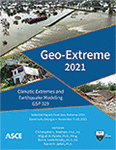Prediction of Matric Suction of Highway Slopes Using Autoregression Artificial Neural Network (ANN) Model
Publication: Geo-Extreme 2021
ABSTRACT
Predictive models using machine learning tools have received increased attention to minimize the negative impact on the environment. Mississippi is considered as one of the wet states in the United States, and the precipitation is considered as the major challenge, and the precipitation pattern is in gradual alteration. The major objective of the current study is to develop an Artificial Neural Network based predictive model of the Yazoo clay soil matric suction to estimate weekly suction variations from field measured instrumentation data. Yazoo clay soil matric suction is one of the influencing factors in the mechanical properties of the soil, which could be an indication of the soil body movement. Six site slopes at different neighborhoods of the Jackson Metroplex area have been instrumented by soil moisture sensor, water potential probe, and precipitation gauge to monitor the change in soil moisture content, soil matric suction, and real precipitation respectively. The installed automated sensors have been located at the 5 ft (1.5 m) depth. The field instrumentation was initiated from mid-August 2018 to the present. The data set has been processed and trained based on generalized autoregression Artificial Neural Network with several backpropagation layers and validated with each target slope. Based on the deep learning analysis results with various performance indices, 98% prediction accuracy was achieved by implementing ANN analysis to the field real measured data.
Get full access to this article
View all available purchase options and get full access to this chapter.
REFERENCES
Alsmadi, M. K. S., Omar, K. B., and Noah, S. A. (2009). “Back Propagation Algorithm: The Best Algorithm Among the Multi-Layer Perceptron Algorithm.” Int. Jr Computer Science and Network Security.
Atluri, V., Chih-Cheng, H., and Coleman, T. L. (1999). An artificial neural network for classifying and predicting soil moisture and temperature using the Levenberg-Marquardt algorithm. IEEE.
Cai, J.-S., Yeh, T.-C. J., Yan, E.-C., Tang, R.-X., Hao, Y.-H., Huang, W.-K., and Wen,J.-C. (2019). “Importance of variability in initial soil moisture and rainfalls on the slopestability.” Journal of Hydrology.
Chai, S.-S., Walker, J. P., Makarynskyy, O., Kuhn, M., Veenendal, B., and West, G. (2010). “Use of Soil Moisture Variability in Artificial Neural Network Retrieval of Soil Moisture.” Jr. Remote Sensing.
De Melo, T. M., and Pedrollo, O. C. (2015). “Artificial Neural Networks for Estimating Soil Water Retention Curve Using Fitted and Measured Data.” Applied and Environmental Soil Science, Hindawi, Vol., 2015, Article ID 535216, p. 16.
D’Emilio, A., Aiello, R., Consoli, S., Vanella, D., and Iovino, M. (2018). “Artificial Neural Networks for Predicting the Water Retention Curve of Sicilian Agricultural Soils.” Water, MDPI, Vol., 10, 1431.
Douglas, S. C., and Dunlap, G. T. (2000). “Light commercial construction on Yazoo clay.” Proc., 2nd Forensic Congress, ASCE, Reston, Va., PTI Manual, Phoenix, Arizona.
Hall, K., and Shreenath, R. (1999). “Predicting Subgrade Moisture Content for Low-Volume Pavement Design Using In Situ Moisture Content Data.” TRB.
Khan, M. S., Ivoke, J., Nobahar, M., and Amini, F. (2020). “Artificial Neural Network (ANN) based predictive Soil Temperature model of High Plastic Yazoo Clay.” Int. Jr. Geomechanics, (Under Review).
Kothari, U. C., and Momayez, M. (2018). “Machine learning: A novel approach to predicting slope instability.” Int. Jr. Geophysics.
Lim, T. T., Rahardjo, H., Chang, M. F., and Fredlund, D. G. (1996). “Effect of rainfall on matric suction in a residual soil slope.” Canadian Geotechnical Jr.
Mas, J. F., and Flores, J. J. (2008). “The Application of Artificial Neural Networks to The Analysis of Remotely Sensed Data.” Int. Jr. of Remote Sensing.
Nobahar, M., Khan, M. S., and Ivoke, J. (2020). “Combined Effect of Rainfall and Shear strength on the Stability of Highway Embankments made of Yazoo Clay in Mississippi.” Geotechnical and Geological Eng.
Russam, K. (1965). The Prediction of Subgrade Moisture Conditions for Design Purposes. In Moisture Equilibria and Moisture Changes in Soils Beneath Covered Areas. Butterworth, Sydney, Australia.
Taylor, A. C. (2005). Mineralogy and engineering properties of the Yazoo clay formation. Jackson Group, Master’s Thesis, Mississippi State University.
Wilby, R. L., Wigley, T. M. L., Conway, D., Jones, P. D., Hewitson, B. C., Main, J., and Wilks, D. S. (1998). “Statistical Downscaling of General Circulation Model Output: A Comparison of Methods.” Water Resources Research.
Liou, Y.-A., Liu, S.-F., and Wang, W.-J. (2001). “Retrieving soil moisture from simulated brightness temperatures by a neural network.” Geoscience and Remote Sensing.
Information & Authors
Information
Published In
Copyright
© 2021 American Society of Civil Engineers.
History
Published online: Nov 4, 2021
Authors
Metrics & Citations
Metrics
Citations
Download citation
If you have the appropriate software installed, you can download article citation data to the citation manager of your choice. Simply select your manager software from the list below and click Download.
Cited by
- Nobahar Masoud, Fei Han, Abolfazl Eslami, Sadik Khan, Farshad Amini, Stability Prediction of Highway Slope on Highly Plastic Clay Using Particle Swarm Optimization (PSO)-Based Neural Network, Geo-Congress 2024, 10.1061/9780784485347.027, (264-274), (2024).
- Nobahar Masoud, Salunke Rakesh, Khan Mohammad Sadik, Amini Farshad, Early Warning Protocol against Highway Slope Failures in Mississippi, Geo-Congress 2023, 10.1061/9780784484692.044, (430-439), (2023).
